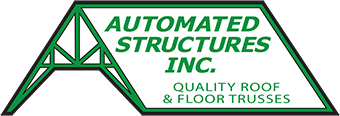
2911 S. Midland Dr
Ogden, UT
801-732-9300



Why use pre-manufactured trusses instead of traditional hand-framing?
- Engineering expertise.
- Complex roof and ceiling configurations made easy.
- Industry standards for manufacturing and code compliance.
- Light weight and easy to install.
- Truss costs can be predetermined accurately to help you stay on budget.
- Floor trusses allow for easy installation of plumbing, wiring and HVAC thru built-in duct runs, also eliminating the need for drops in the ceiling.
- Generates less on-site waste and theft, improving safety and reducing clean-up.
What is a girder?
A girder is a truss that supports the load from other trusses that either hang into it or sit on top of it.
What is the heel height of a truss?
The heel height is a measure of the plumb height at the end of the truss, usually where it sits on the wall.


What is the snow load for my location?
Snow load, which is measured in pounds per square foot, varies greatly from location to location, depending on elevation and regional weather averages. The local building department is the place to find out the loading information for you specific location.
What is the difference between Live Load and Dead Load?
The loads applied to a structure are separated into different types of load.
Live Loads are from things that aren't permanent, such as snow and the weight of people moving thru a building.
Dead Loads are from things that are always there, such as the weight of tiles or shingles.
Can I drill a hole in a truss, or cut a piece out?
NO! Unlike TJIs and wall studs, holes are not permissible in trusses.
They are engineered for specific loads and locations, and a hole or cut creates a weak point in the system. Trusses can be thought of as the skeleton of a roof or floor system. If you have a hole a break occur in a bone, it needs to be supported with a cast and repaired. Similarly, any holes or other damage to a truss will require it to be repaired and reinforced in some way, according to the instructions of a licensed structural engineer.


© 2017 Automated Structures, Inc.